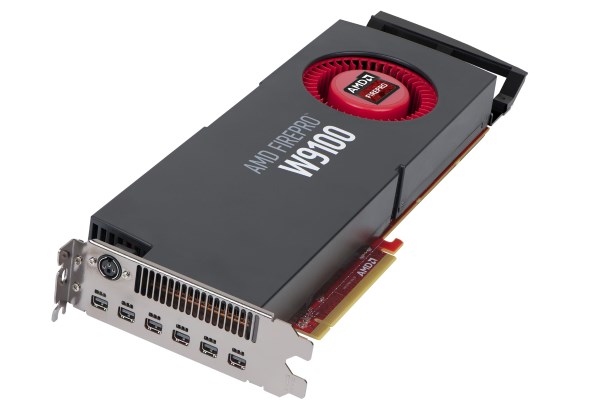AMD FirePro W9100 vs NVIDIA Quadro K6000
Introduction
It has been almost two years since AMD launched the FirePro W9000 and kicked off a new battle in the workstation GPU wars. Today, we're reviewing the company's FirePro W9100 -- a new card based on the same Hawaii-class GPU as the desktop R9 290 and R9 290X, but aimed at the workstation market and professional consumers. Does AMD's new card have what it takes to seize the professional performance crown?
The W9100 is a full Hawaii GPU with 2,816 stream processors, 320GB/s of memory bandwidth, and six mini-DisplayPorts, all of which support DP1.2 and 4K output. It carries more RAM than any other AMD GPU -- a whopping 16GB of GDDR5 on a single card. Even NVIDIA's top-end Quadro K6000 tops out at 12GB, which means AMD sits in a class by itself in this area. The W9000 and W9100 have one other major point of differentiation -- each offers support for up to six 4K displays using DisplayPort 1.2. NVIDIA's top-end Quadro K6000 tops out at just two DP 1.2 ports. You can still theoretically run more DisplayPort 1.2 displays if you use a hub, but if you want to hook everything up through the video card, AMD has a distinct advantage here.
Customers who follow the consumer market may be concerned that the W9100 is loud -- the R9 290 and R9 290X are known for it -- but that's not an issue with the higher-end workstation cards. The W9100 is big, though -- AMD ships it with a bracket for stabilizing the card in full-tower cases.
Understanding the Workstation Market:
The first thing we need to talk about is the difference between workstation and consumer GPUs. The GPUs themselves are essentially identical -- NVIDIA's Quadro K6000 is based on GK104 (Kepler) the older Quadro 6000 is a GF100 (Fermi)-based chip, the W9000 uses the same GCN core that powers the HD 7970/R9 280X, and today's W9100 is essentially identical to the Hawaii XT core inside the R9 290X. What sets these workstation cards aside are the amount of RAM they carry (typically 2-3x as much as a consumer card), their validation cycles (workstation GPU cores are hammered on far more than the consumer equivalents) and the amount of backend vendor support and optimization that AMD and NVIDIA both perform.
This optimization process and long-term vendor partnership is what distinguishes the workstation market from the consumer space and the need to pay for some of those development costs is part of why workstation cards tend to cost so much more than their consumer equivalents. Historically, it's a market that NVIDIA has dominated. AMD has begun to reverse this with its high-profile Mac Pro win, but the total workstation GPU market is estimated at 78.8% NVIDIA, 20.6% AMD. Counting strictly Windows and Linux, the market split is 82.8% NVIDIA, 16.5% AMD.
For our comparison we've put the W9100 up against the newer, Kepler-based Quadro K6000, the older Fermi-based Quadro 6000, and the W9000.
The W9100 is a full Hawaii GPU with 2,816 stream processors, 320GB/s of memory bandwidth, and six mini-DisplayPorts, all of which support DP1.2 and 4K output. It carries more RAM than any other AMD GPU -- a whopping 16GB of GDDR5 on a single card. Even NVIDIA's top-end Quadro K6000 tops out at 12GB, which means AMD sits in a class by itself in this area. The W9000 and W9100 have one other major point of differentiation -- each offers support for up to six 4K displays using DisplayPort 1.2. NVIDIA's top-end Quadro K6000 tops out at just two DP 1.2 ports. You can still theoretically run more DisplayPort 1.2 displays if you use a hub, but if you want to hook everything up through the video card, AMD has a distinct advantage here.

Find The AMD FirePro W9100 @ Amazon.com
|
|
Memory
Compute Performance
Display Outputs
Cooling/Power/Form Factor
|
API/Features/OS Support
System Requirements
|
Customers who follow the consumer market may be concerned that the W9100 is loud -- the R9 290 and R9 290X are known for it -- but that's not an issue with the higher-end workstation cards. The W9100 is big, though -- AMD ships it with a bracket for stabilizing the card in full-tower cases.
Understanding the Workstation Market:
The first thing we need to talk about is the difference between workstation and consumer GPUs. The GPUs themselves are essentially identical -- NVIDIA's Quadro K6000 is based on GK104 (Kepler) the older Quadro 6000 is a GF100 (Fermi)-based chip, the W9000 uses the same GCN core that powers the HD 7970/R9 280X, and today's W9100 is essentially identical to the Hawaii XT core inside the R9 290X. What sets these workstation cards aside are the amount of RAM they carry (typically 2-3x as much as a consumer card), their validation cycles (workstation GPU cores are hammered on far more than the consumer equivalents) and the amount of backend vendor support and optimization that AMD and NVIDIA both perform.
This optimization process and long-term vendor partnership is what distinguishes the workstation market from the consumer space and the need to pay for some of those development costs is part of why workstation cards tend to cost so much more than their consumer equivalents. Historically, it's a market that NVIDIA has dominated. AMD has begun to reverse this with its high-profile Mac Pro win, but the total workstation GPU market is estimated at 78.8% NVIDIA, 20.6% AMD. Counting strictly Windows and Linux, the market split is 82.8% NVIDIA, 16.5% AMD.
For our comparison we've put the W9100 up against the newer, Kepler-based Quadro K6000, the older Fermi-based Quadro 6000, and the W9000.







